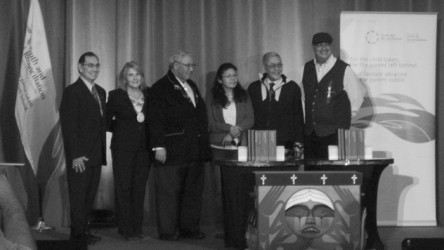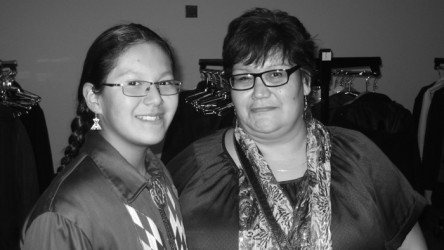Article Origin
Volume
Issue
Year
Twelve-year-old traditional singer, Theland Kicknosawy (Odawa/Potawatomi), led the procession into the room where the commissioners of the Truth and Reconciliation Commission awaited to present their final report in Ottawa yesterday.
Chairman Justice Murray Sinclair (Ojibway), opened the event encouraging the young First Nation boy to walk tall and continue to sing his Honor Song.
Sinclair acknowledged Kicknosawy as an example of “what could have always been.” Then, indicated the two empty chairs beside him to symbolize the boys and girls who did not survive Indian residential schools.
It was an emotional gathering, but one that came with a sigh of relief. The Truth and Reconciliation Commission has finished its mandate.
†“We are not the same people as when we started, and neither is this country,” said Sinclair. He spoke of the actions and commitments to be taken, marking the “threshold of a new era in a period of change” that must be sustained by the people from all sectors, the partners, the politicians, and individuals, who are now aware of the detrimental policies to assimilate, acculturate, indoctrinate, and destroy Indigenous identities.
“Change will take years, perhaps generations, but we cannot be daunted by the task because our goal is a just one, and we owe it to our children,” he said.
Fellow commissioner, Chief Wilton Littlechild (Cree) continued by sharing the Principles of Reconciliation before the large crowd of families of survivors, local Aboriginal community members, allies, †members of Parliament, Prime Minister Justin Trudeau, and federal, provincial and territorial Cabinet members.
The principles include the right to Indigenous languages, spiritual expression, traditional laws and protocols, and to the treaties.
“Reconciliation is a national responsibility. We must all serve as the champions for the changes we are calling for.”
Commissioner Dr. Marie Wilson, reminded all that it was the “survivors who fought for Truth and Reconciliation; they provoked this national dialogue that is beginning to transform our country.”
The report contains six volumes covering the history (pre-confederation roots) of assimilation policies, the Inuit and MÈtis experience, the deaths and missing records, the intergenerational impact of residential schools and the need for a concrete measure of the damages done.
Eugene Arcand (Cree), member of the Indian Residential Schools Survivor Committee, reminded the crowd that “media often refers to the TRC report’s recommendations, but these are calls to action. Canada has been awakened. This is your rite to passage.”
When Prime Minister Trudeau addressed the crowd, he reminisced about his own privileged school days in comparison to the education residential school survivors received, and remembered when his history teacher dismissed Aboriginal content as “not important”.
He then made an open promise that “this is an integral part of Canadian history. I give you my word that we will renew and respect the relationship between Canada and Indigenous peoples. The burden is now ours as a government and country.”
He finished by stating the final report “sets us squarely on the path to true reconciliation and I enter that relationship in partnership and friendship.”
- 1918 views


